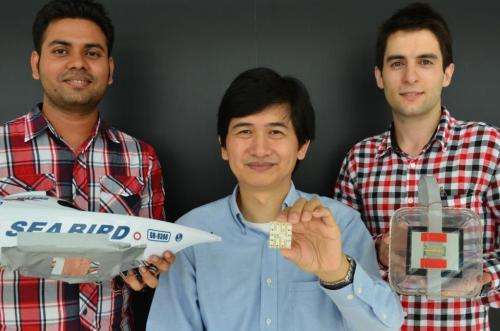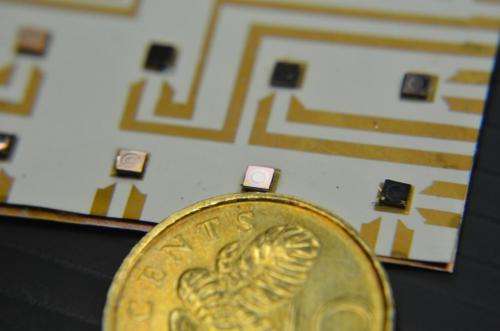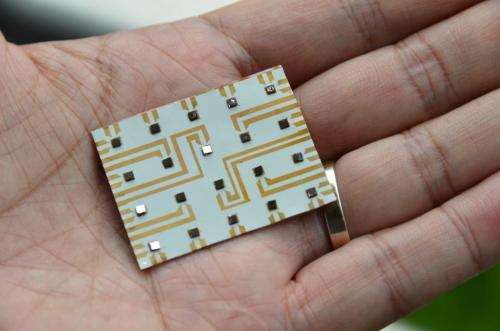'Sense-ational' invention helps underwater vessels navigate with ease

Nanyang Technological University (NTU) scientists have invented a 'sense-ational' device, similar to a string of 'feelers' found on the bodies of the Blind Cave Fish, which enables the fish to sense their surrounding and so navigate easily.
Using a combination of water pressure and computer vision technology, the sensory device is able to give users a 3-D image of nearby objects and map its surroundings. The possible applications of this fish-inspired sensor are enormous. The sensor can potentially replace the expensive 'eyes and ears' on Autonomous Underwater Vehicles (AUVs), submarines and boats that currently rely on cameras and sonars to gather information about the environment around them.
The revolutionary, low-powered sensor is unlike cameras which cannot see in dark or murky waters; or sonars whose sound waves pose harm to some marine animals.
These extremely small sensors (each sensor is 1.8mm x 1.8mm) are now being used in AUVs developed by researchers from Singapore-MIT Alliance for Research and Technology (SMART), a research centre funded by the National Research Foundation. The centre is developing a new generation of underwater 'stingray-like' robots and autonomous surface vessels.
The new sensors, made using Microelectromechanical Systems (MEMS) technology, will make such robots smarter and prolong their operational time as battery power is conserved.
Associate Professor Miao Jianmin from the School of Mechanical and Aerospace Engineering, and his team of four have spent the last five years in collaboration with SMART to develop micro-sensors that mimic the row of 'feelers' on both sides of the Blind cave fish's body.

Associate Prof Miao said the line of sensors present on the fish's body is the reason why it can sense objects around it and still travel at high speeds without colliding with any underwater obstacles.
"To mimic nature, our team created microscopic sensory pillars wrapped in hydrogel - a material which is similar to the natural neuromasts of the blind cave fish - into an array of two rows of five sensors," Prof Miao said.
"This array of micro-sensors will then allow AUVs to locate, identify, and classify obstacles and objects in water through water pressure and also to optimise its movement in water by sensing the water flow."
The new sensor array which costs below S$100 to make, is also more affordable than sonars, which can detect faraway objects but not nearby objects and cost thousands of dollars.
Partnering Prof Miao to develop the sensors and to adopt it for use on AUVs is Professor Michael Triantafyllou from SMART. Prof Triantafyllou, from SMART's Centre for Environmental Sensing and Modeling (CENSAM), is one of the world's foremost experts on creating underwater robots modelled after aquatic animals like fish.

Current problems with AUVs include poor navigation in murky or cloudy waters such as those off the coast of Singapore, as underwater cameras can only see a short distance, Prof Triantafyllou said.
"Other methods like underwater lights and cameras, acoustic navigation, and sonars also work, but they are very expensive and require very high levels of power that drain the batteries. The new sensors are much cheaper and only require small amounts of power. Also, sensors like sonar are loud and invasive and they may harm aquatic animals that also use sound waves to navigate," the Massachusetts Institute of Technology professor added.
The aim of the AUVs is for environmental sensing, to detect environmental pollution, contaminants and to monitor the overall water quality in Singapore's waters. The AUVs will have chemical sensors installed to detect the chemical condition of water (dissolved oxygen, nutrients, metals, oils, and pesticides), and biological sensors to monitor water conditions such as harmful bacteria and pathogens.
Other potential application of these MEMS sensors, which specialises in near-field detection include defence applications. These can detect nearby submarines without the use of sonar thatgives away one's location.
This collaborative research resulted in two breakthrough papers being accepted for presentation at a prestigious MEMS conference next January in Taiwan, organised by the Institute of Electrical and Electronics Engineers (IEEE).
One paper is for the development of the piezoelectric sensor which does not require any energy as it generates an electric voltage when water flows past the 'feelers'. The second paper focuses on a low-powered biomimetic sensor which can detect underwater objects even when there is little water flowing past it.
To further improve the sensor, Prof Miao's team is now looking to develop a hybrid sensor which will combine both the zero-energy piezoelectric sensor's high accuracy with the low-powered static sensor's ability to detect objects in still water.
Provided by Nanyang Technological University




















